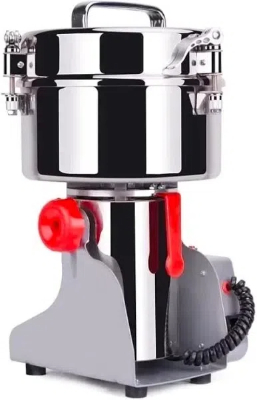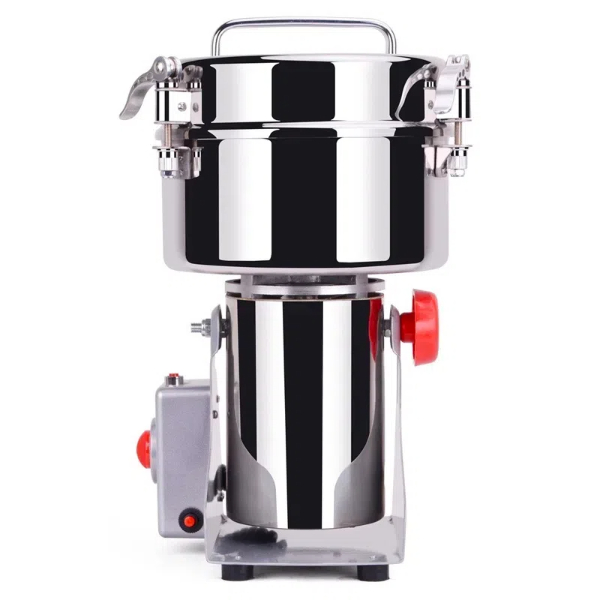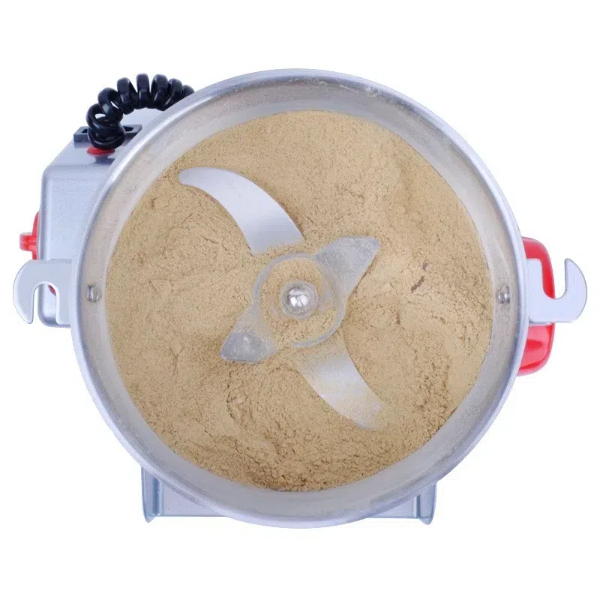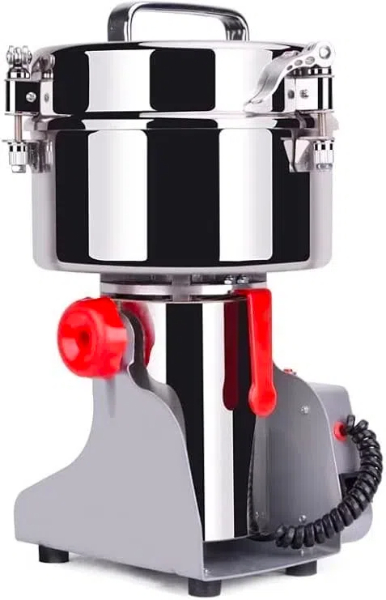
Content Menu
● Introduction
● Understanding Dry Food Grinding Machines
● Types of Dry Food Grinding Machines
>> 1. Electric Grain Mills
>> 2. Commercial Spice Grinders
>> 3. Multifunctional Dry Food Processors
>> 4. Industrial Food Grinding Equipment
● Applications of Dry Food Grinding Machines
>> 1. Flour Milling
>> 2. Spice Blending
>> 3. Coffee Grinding
>> 4. Nut Butter Production
>> 5. Herbal Medicine Preparation
● Benefits of Using a Dry Food Grinding Machine
>> 1. Freshness and Flavor
>> 2. Nutritional Value
>> 3. Customization
>> 4. Cost-Effectiveness
>> 5. Reduced Food Waste
● Choosing the Right Dry Food Grinding Machine
>> 1. Intended Use
>> 2. Capacity
>> 3. Motor Power
>> 4. Grinding Mechanism
>> 5. Material and Build Quality
>> 6. Noise Level
● Maintenance and Care
● Innovative Features in Modern Dry Food Grinding Machines
>> 1. Digital Controls
>> 2. Preset Programs
>> 3. Safety Features
>> 4. Noise Reduction Technology
>> 5. Smart Connectivity
● Conclusion
● Frequently Asked Questions
>> 1. What types of ingredients can I process in a dry food grinding machine?
>> 2. How do I clean my dry food grinding machine?
>> 3. Can I grind wet ingredients in a dry food grinding machine?
>> 4. How long does it take to grind ingredients in a dry food grinding machine?
>> 5. Are dry food grinding machines noisy?
Introduction
In today's fast-paced culinary world, efficiency and versatility are key factors in both home and commercial kitchens. One tool that has become increasingly popular and essential is the dry food grinding machine. These powerful devices have revolutionized the way we process ingredients, offering a quick and efficient method to transform whole grains, spices, herbs, and other dry foods into fine powders or custom textures. In this comprehensive guide, we'll explore the world of dry food grinding machines, their applications, benefits, and how they're changing the game for food enthusiasts and professionals alike.
Understanding Dry Food Grinding Machines
A dry food grinding machine, also known as an electric grain mill or commercial spice grinder, is a versatile kitchen appliance designed to process a wide variety of dry ingredients. These machines typically feature a powerful motor, durable grinding mechanisms, and adjustable settings to achieve desired textures and particle sizes.
The core component of a dry food grinding machine is its grinding chamber, which houses either stainless steel blades, burrs, or plates. These elements work together to break down ingredients into smaller particles, ranging from coarse grinds to ultra-fine powders. The versatility of these machines makes them indispensable for various culinary applications, from creating freshly ground flours to preparing aromatic spice blends.

Types of Dry Food Grinding Machines
1. Electric Grain Mills
Electric grain mills are popular among home bakers and health enthusiasts who prefer freshly ground flours. These machines are designed to handle various grains, including wheat, corn, rice, and oats. With adjustable settings, users can achieve different levels of coarseness, allowing for customized flour textures suitable for various recipes.
2. Commercial Spice Grinders
Commercial spice grinders are heavy-duty machines built to handle large quantities of spices and herbs. These high-speed dry food pulverizers are essential in restaurants, spice shops, and food manufacturing facilities. They can quickly process tough ingredients like cinnamon sticks, peppercorns, and dried chilies into fine powders, ensuring consistent flavor profiles in culinary creations.
3. Multifunctional Dry Food Processors
These versatile machines combine the functionalities of various grinding tools into one compact unit. A multifunctional dry food processor can handle a wide range of ingredients, from grains and spices to nuts and dried fruits. This type of dry food grinding machine is ideal for home cooks and small businesses that require flexibility in their food processing needs.
4. Industrial Food Grinding Equipment
For large-scale food production, industrial food grinding equipment is essential. These robust machines are designed to handle continuous operation and high volumes of ingredients. They often feature advanced technologies for precise particle size control and are built to meet strict hygiene standards in commercial food processing environments.
Applications of Dry Food Grinding Machines
The versatility of dry food grinding machines makes them valuable in various settings, from home kitchens to large-scale food manufacturing facilities. Here are some common applications:
1. Flour Milling
One of the primary uses of dry food grinding machines is flour milling. Home bakers and artisanal bakeries use electric grain mills to produce fresh, nutrient-rich flours from whole grains. This process allows for greater control over the flour's texture and nutritional content, resulting in superior baked goods.
2. Spice Blending
Commercial spice grinders and herb grinding machines are crucial in the spice industry. These devices allow for the creation of custom spice blends, ensuring consistent flavor profiles and particle sizes. From aromatic curry powders to zesty barbecue rubs, dry food grinding machines play a vital role in crafting unique seasoning mixes.
3. Coffee Grinding
While specialized coffee grinders exist, many dry food grinding machines are capable of processing coffee beans. This versatility is particularly useful for small cafes or home baristas who want to experiment with different coffee grinds without investing in a separate machine.
4. Nut Butter Production
Dry food grinding machines equipped with powerful motors can transform nuts into smooth, creamy nut butters. This application is popular among health food enthusiasts and small-scale producers looking to create artisanal nut butter varieties.
5. Herbal Medicine Preparation
In the field of traditional and alternative medicine, dry food grinding machines are used to process dried herbs and roots into fine powders. This allows for the creation of herbal supplements, teas, and other natural remedies.

Benefits of Using a Dry Food Grinding Machine
Incorporating a dry food grinding machine into your kitchen or food production facility offers numerous advantages:
1. Freshness and Flavor
By grinding ingredients on-demand, you ensure maximum freshness and flavor retention. This is particularly important for spices and coffee, where volatile oils can quickly dissipate once the ingredients are ground.
2. Nutritional Value
Freshly ground flours and powders retain more nutrients compared to pre-ground alternatives. The dry food grinding process preserves essential vitamins and minerals that might otherwise degrade during long-term storage.
3. Customization
With adjustable settings, dry food grinding machines allow users to customize the texture and particle size of their ground ingredients. This level of control is invaluable for achieving specific culinary results or meeting individual dietary preferences.
4. Cost-Effectiveness
Investing in a dry food grinding machine can lead to significant cost savings over time. Purchasing whole ingredients in bulk and grinding them as needed is often more economical than buying pre-ground products.
5. Reduced Food Waste
By grinding only what you need, you can reduce food waste and extend the shelf life of your ingredients. Whole grains and spices typically have a longer storage life compared to their ground counterparts.
Choosing the Right Dry Food Grinding Machine
When selecting a dry food grinding machine, consider the following factors:
1. Intended Use
Determine your primary grinding needs. Are you mainly interested in milling flour, grinding spices, or do you require a multifunctional machine? Your intended use will guide you towards the most suitable type of grinder.
2. Capacity
Consider the volume of ingredients you'll be processing regularly. Home users may be satisfied with smaller machines, while commercial kitchens or food production facilities will require larger, more robust models.
3. Motor Power
The motor's power directly affects the machine's ability to handle tough ingredients and maintain consistent performance. Look for higher wattage in machines intended for heavy-duty use or processing hard ingredients.
4. Grinding Mechanism
Different grinding mechanisms suit various ingredients. Burr grinders are excellent for achieving consistent particle sizes, while blade grinders offer versatility for a wide range of ingredients.
5. Material and Build Quality
Opt for machines with high-quality, food-grade materials like stainless steel. Durable construction ensures longevity and ease of cleaning, which is crucial for maintaining hygiene standards.
6. Noise Level
Consider the operating noise, especially if you'll be using the machine in a home setting or a noise-sensitive environment. Some models offer quieter operation, which can be a significant advantage.
Maintenance and Care
Proper maintenance of your dry food grinding machine is essential for ensuring its longevity and optimal performance. Here are some key tips:
1. Clean the grinding chamber and components after each use to prevent residue buildup.
2. Follow the manufacturer's instructions for disassembly and cleaning.
3. Store the machine in a dry place to prevent moisture-related issues.
4. Regularly inspect the grinding mechanism for signs of wear and replace parts as needed.
5. Avoid overloading the machine beyond its recommended capacity to prevent motor strain.
Innovative Features in Modern Dry Food Grinding Machines
As technology advances, dry food grinding machines continue to evolve, incorporating new features to enhance user experience and functionality:
1. Digital Controls
Many modern machines now feature digital displays and touch controls, allowing for precise setting adjustments and easy monitoring of grinding time and speed.
2. Preset Programs
Some advanced models offer preset grinding programs for common ingredients, taking the guesswork out of achieving the perfect grind for specific foods.
3. Safety Features
Improved safety mechanisms, such as automatic shut-off systems and overheating protection, ensure safer operation and protect both the user and the machine.
4. Noise Reduction Technology
Manufacturers are developing innovative ways to reduce operational noise, making dry food grinding machines more suitable for various environments.
5. Smart Connectivity
Emerging smart kitchen appliances include dry food grinding machines that can be controlled via smartphone apps, offering remote operation and custom recipe programming.
Conclusion
Dry food grinding machines have become indispensable tools in both home and commercial kitchens. Their ability to efficiently process a wide range of ingredients opens up new possibilities for culinary creativity and food production. Whether you're a home cook looking to mill your own flour or a commercial food producer seeking to create custom spice blends, investing in a quality dry food grinding machine can significantly enhance your culinary capabilities.
As technology continues to advance, we can expect to see even more innovative features and improvements in these versatile machines. The future of dry food grinding looks bright, with smarter, more efficient, and user-friendly devices on the horizon. By understanding the types, applications, and benefits of dry food grinding machines, you can make an informed decision when choosing the right equipment for your needs, ultimately elevating your culinary endeavors to new heights.

Frequently Asked Questions
1. What types of ingredients can I process in a dry food grinding machine?
Answer: Dry food grinding machines are versatile and can process a wide range of ingredients, including grains (wheat, rice, corn), spices (peppercorns, cinnamon, cumin), herbs, nuts, seeds, and even some dried fruits. However, it's important to check your specific machine's capabilities, as some models may have limitations on certain ingredients.
2. How do I clean my dry food grinding machine?
Answer: Cleaning methods may vary depending on the model, but generally, you should:
1. Unplug the machine and disassemble removable parts.
2. Brush out any remaining particles from the grinding chamber.
3. Wipe down the interior and exterior with a damp cloth.
4. For stubborn residues, use a mild soap solution and rinse thoroughly.
5. Dry all components completely before reassembling.
Always refer to your machine's user manual for specific cleaning instructions.
3. Can I grind wet ingredients in a dry food grinding machine?
Answer: Most dry food grinding machines are designed specifically for dry ingredients and should not be used with wet or oily substances. Using wet ingredients can damage the machine, affect its performance, and potentially create safety hazards. If you need to process wet ingredients, look for a dedicated wet grinder or a multi-purpose food processor.
4. How long does it take to grind ingredients in a dry food grinding machine?
Answer: Grinding time varies depending on the ingredient, desired fineness, and the machine's power. Generally, small batches of spices might take 30 seconds to 2 minutes, while larger quantities of grains for flour could take 3-5 minutes or more. Always follow the manufacturer's recommendations and avoid overheating the machine by grinding in short bursts if necessary.
5. Are dry food grinding machines noisy?
Answer: Dry food grinding machines can be quite noisy due to the high-speed motors and grinding mechanisms. However, noise levels vary between models. Some newer machines incorporate noise-reduction technologies to minimize sound output. If noise is a concern, look for models specifically designed for quieter operation or consider using the machine in a less noise-sensitive area of your home or facility.












